Good morning everyone, and welcome back to another edition of Marvel Masterpieces Parallels in Masterpiece Theater here on Hipsters of the Coast! I’m continuing my exploration of Upper Deck’s Marvel Masterpieces from 2016-2020, a continuation of my deep dive into the most recent Marvel Masterpieces 2020 set by Dave Palumbo. As I neared that series completion in 2021, I became curious about how Palumbo’s work would connect to the previous two “modern” Masterpiece sets that came before him. The 2016 set was done by Joe Jusko, artist of the first Marvel Masterpieces set in 1992. And in 2018, the hugely popular Italian comic artist Simone Bianchi followed in his footsteps, and completed his own Marvel Masterpieces set with new characters, new Battle Spectra scenes, and an entirely different stylistic take on the Marvel universe.
Each of the three sets are completely unique, and puts an artist’s style in the full spotlight. Jusko’s look is classic comic book, with all the muscle, color, and vibrancy of the sets from the 1990s, but reimagined with nostalgia for a new century. Bianchi is more contemporary: darker and grittier with bold blacks and colored outlines to make his characters distinct and out of this world. Palumbo falls somewhere in the middle: his big brushstrokes give a painterly feel to the genre, and bring a balance to the modern Masterpieces. His rendition especially is something that trading cards have never seen.
Across the three sets 2016-2020, there are 42 characters that were painted into each set at least once, and several characters that have multiple appearances within a given year. In total we’ll look at more than 175 artworks throughout this series from each of the last three iterations of Marvel Masterpieces. We’ll compare and contrast each artist’s creation, and learn some pretty cool stuff directly from the artist’s themselves along the way. This series isn’t about picking the best work, but rather talking about why each is a Masterpiece in its own right, and how these works function as a family of premier illustrations both within and across their respective sets.
As I was planning this series from the first article, I knew we’d be getting a bit esoteric towards the end. This is a bit of a shorter journey with less character and less art, but we had a long way to get there, all the way to the stars. This is Parallels: Heroes in Space!
Captain Marvel
Captain Marvel has appeared in various forms and costumes over the heroes history since first appearing in 1967. To try and track the history and aliases of the hero known as Captain Marvel is something I unfortunately don’t have the word count for. Luckily, the Captain Marvel of the modern Marvel Masterpieces all appears as the latest incarnation Carol Danvers, and that makes our job just a little easier.
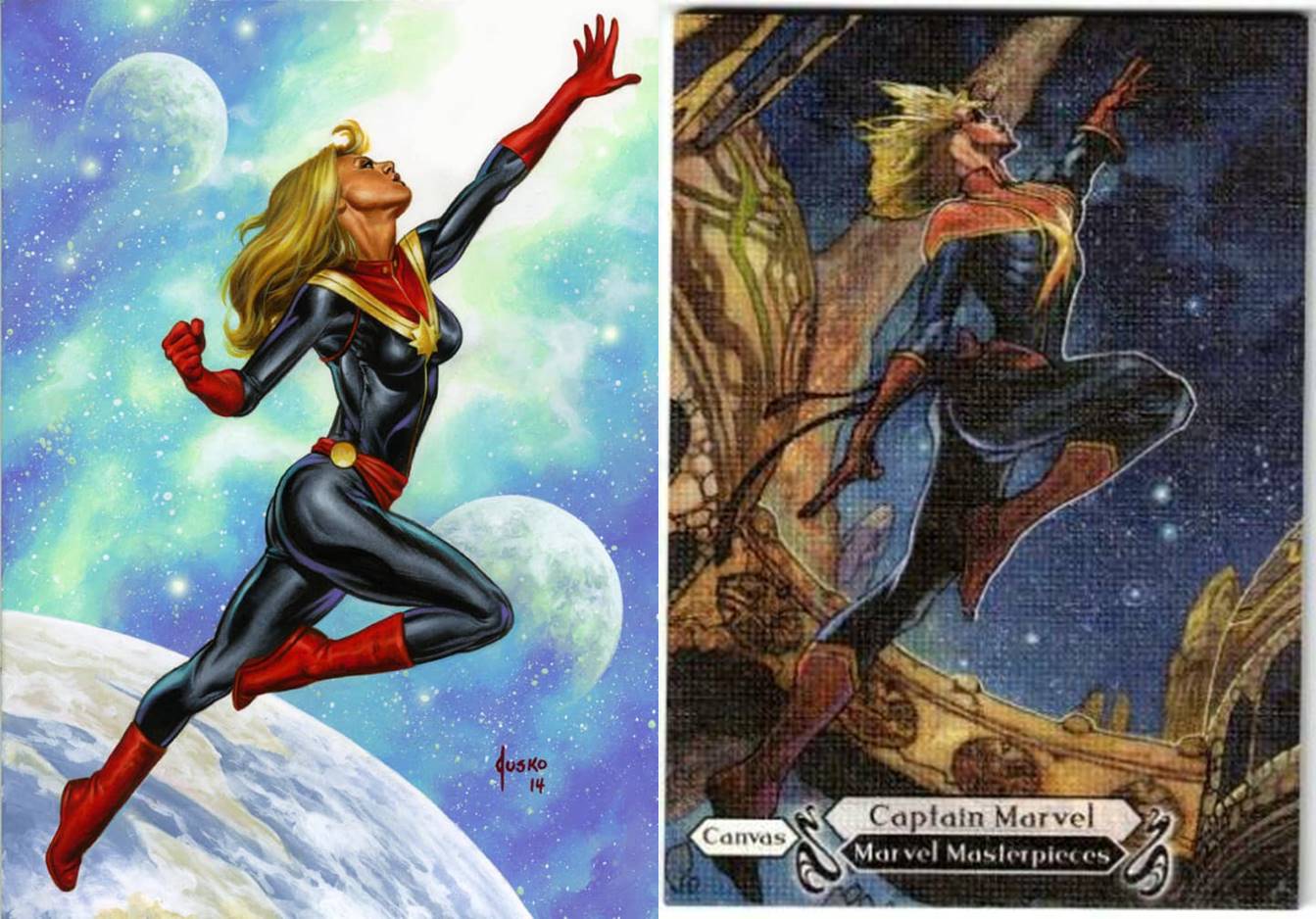
Left to Right: Captain Marvel by Joe Jusko, 2016; Captain Marvel (Canvas Gallery) by Simone Bianchi, 2018.
We begin with as close a parallel as we’ve seen. Our heroine in an almost identical classic superhero take-off, with some slight variations that highlight the artistic differences in the two creators. Jusko’s Marvel has long flowing hair, a clenched fist, and is set against an interplanetary backdrop. It’s graceful and effortless, and one of my favorites in the entire 2016 set. Bianchi takes this same idealistic pose but changes her costume to the more contemporized version that incorporates her mohawk helmet and brings back the sash she wore as Ms. Marvel. We also get a peek of Bianchi’s penchant for architecture, as she’s still in space but on an unknown (likely-Kree) planet.
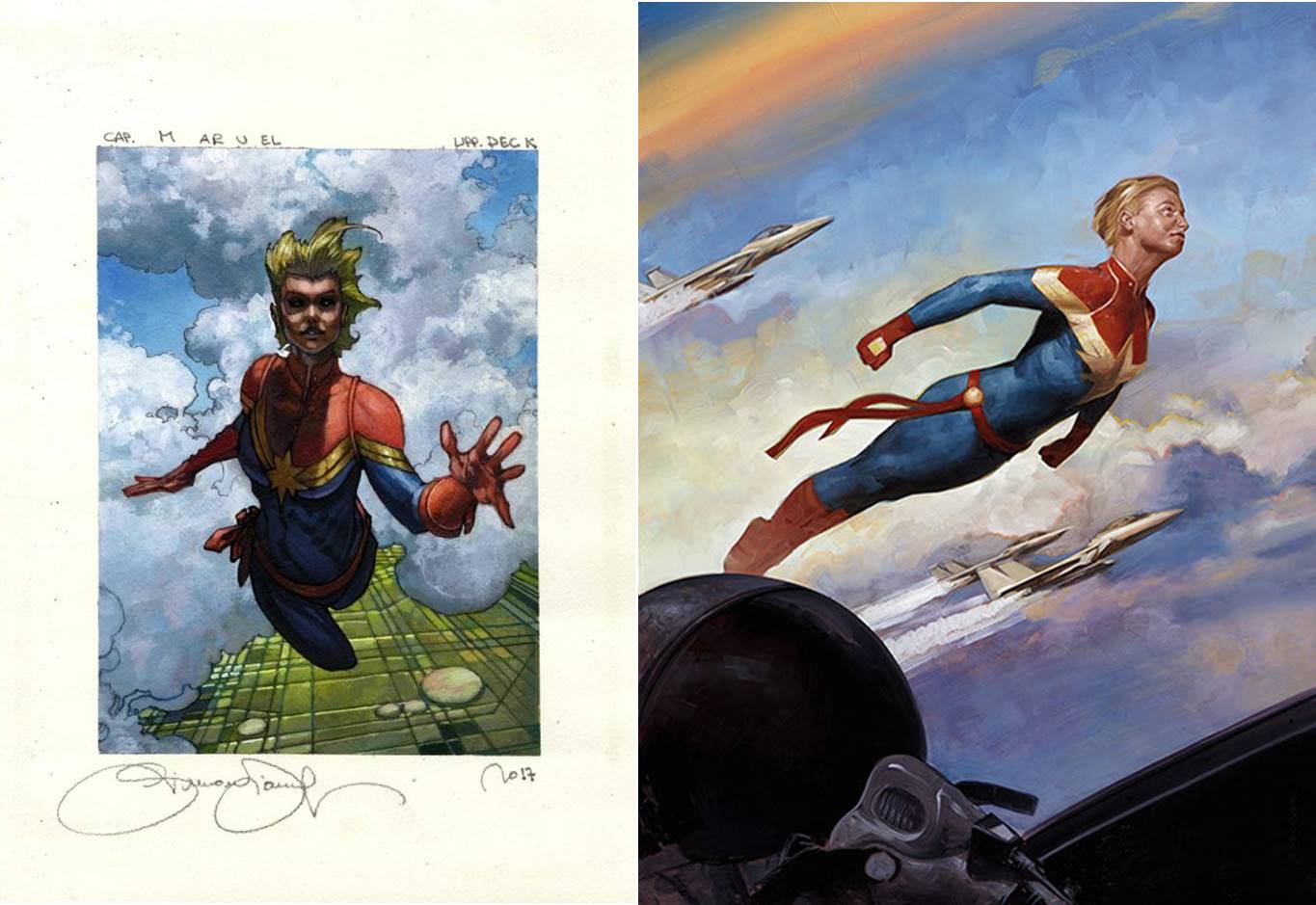
Left: Captain Marvel (Base) by Simone Bianchi, 2018; Right: Captain Marvel by Dave Palumbo, 2020.
These three sets also include Captain Marvel in action, less archetypal depictions but rather her doing what she does best. Bianchi’s other work sends the Captain straight at us, still clearly in the air amongst the clouds, but as if she’s about to explode out of the frame headed towards whatever is at our six. And Palumbo incorporates her background as an officer of the United States Air Force for the first time, as she is one with the jets she’s fighting alongside. You can even see a pilot helmet in the bottom left, as if we’re in the plane watching her go by.
Groot
Continuing on our extraterrestrial expedition brings us to Groot, the sentient-tree foe turned friend that first appeared in Tales to Astonish way back in 1960. He would have only a handful of appearances through the next couple decades before joining the Guardians of the Galaxy in the mid-2000s. His multiple age-ranges from the Marvel Cinematic Universe and signature line of “I Am Groot” have permeated popular culture, and today he’s one of the most recognizable characters in all of Marvel.
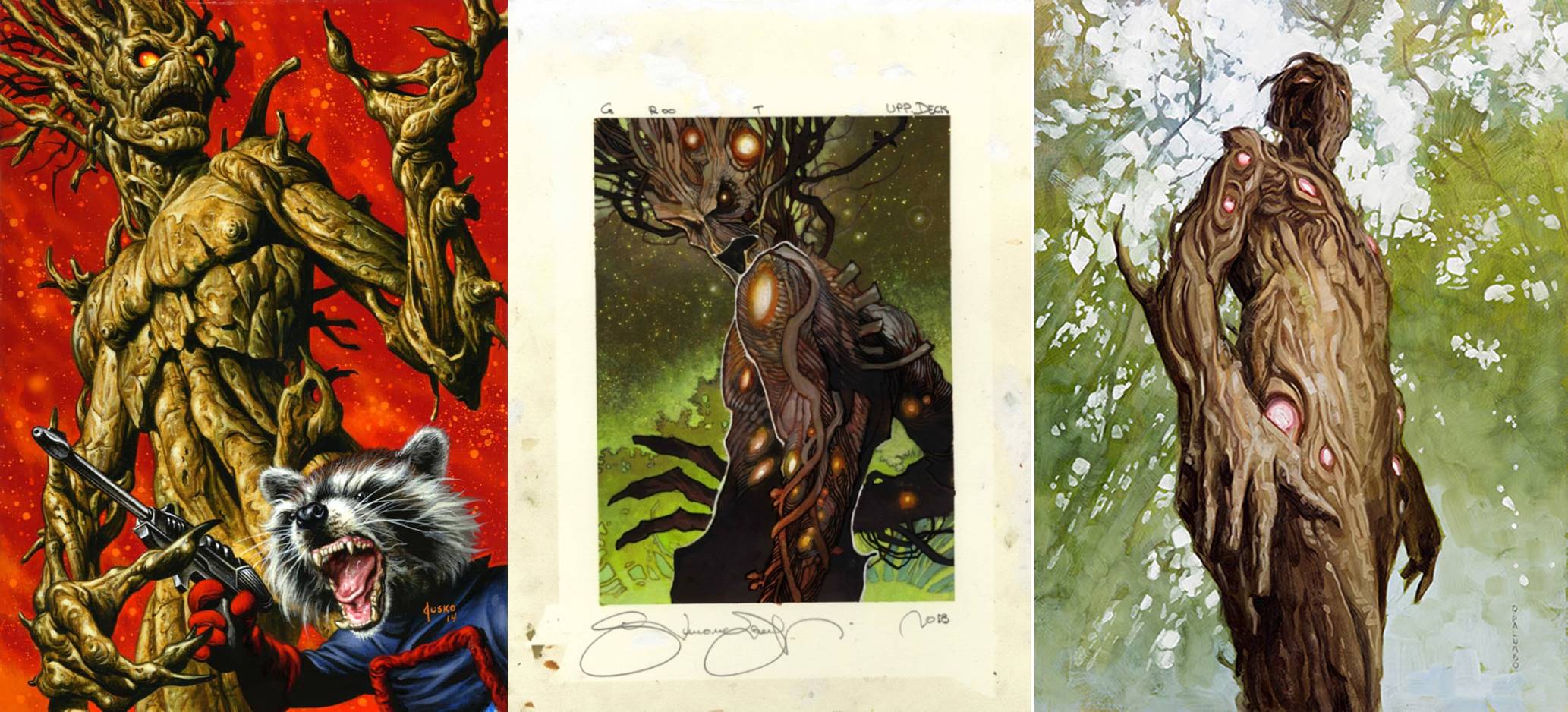
Left to right: Groot by Joe Jusko, 2016; Groot by Simone Bianchi, 2018; Groot by Dave Palumbo, 2020.
He appears once each set from 2016-2020, and each is a bit different but yet still conveys the same feelings of immensity and scale. Jusko’s version is much more organic, with Groot appearing as simply bark without any of the embedded space bits. He’s also included his sidekick Rocket, who would also have his own card in the 2016 set. Bianchi’s Groot has a bit more fervor, almost as if we’ve caught him off-guard, mid battle, and perhaps are interrupting something. And Palumbo sets his Groot within a forest, on the nose of his being a tree himself and the immense scale compared to those around him.
In each of these Groot is larger than life, which is no easy feat to accomplish at trading card size. I expect we’ll see yet another version of the character in the next upcoming Masterpieces set.
Star-Lord
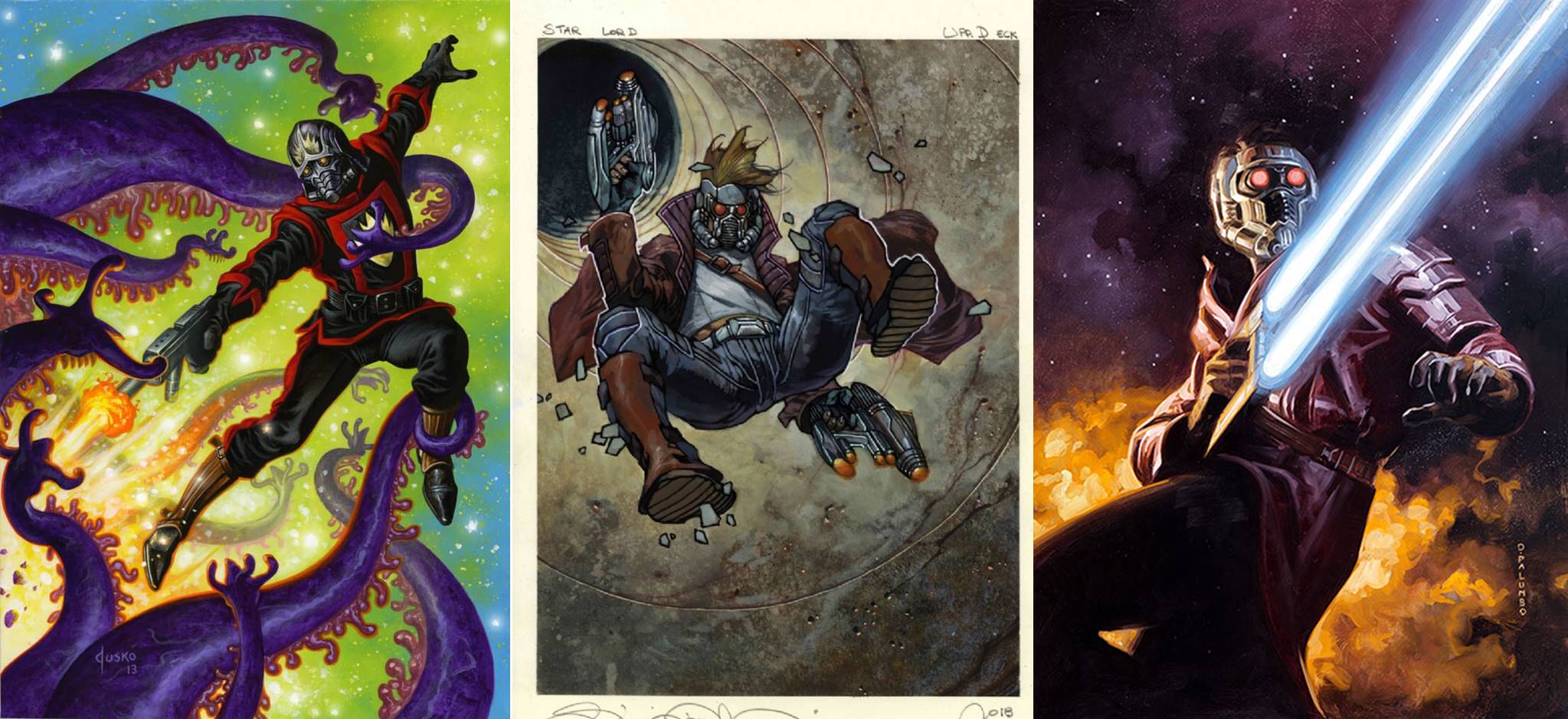
Left to right: Star-Lord by Joe Jusko, 2016; Star-Lord by Simone Bianchi, 2018; Star-Lord by Dave Palumbo, 2020.
Groot’s Guardians of the Galaxy brother is up next. Peter Jason Quill, better known to us as Star-Lord, legendary outlaw. He also appears once in each set, and we see some historical variation in just how he’s depicted. Jusko mentions in his book he much preferred Star-Lord’s original suit he painted for his very first Marvel cover, but instead was made to go with an earlier version of his most current costume, featuring the retractable mask and helmet. I’m pretty sure he’s fighting the creature we see in the opening fight scene of Guardian of the Galaxy Vol. 2.
Bianchi and Palumbo both show Quill in the costume most recently donned in the movies and comics books, as well as showing off the blaster he’s so endeared to. Again we see each artist doing what they do best, with Bianchi using textures and architecture and Palumbo capturing deep space to make the character feel right at home.
Nova
Our final stop on this space odyssey is with a character I’m not particularly familiar with, and that’s Nova. A member of the Xandarian Nova Corps police force, he derives his power from an energy source called the Nova Force, allowing him to both fly and absorb energy. He’s perhaps most beloved from his time with the New Warriors, and has been around for longer than you might think.
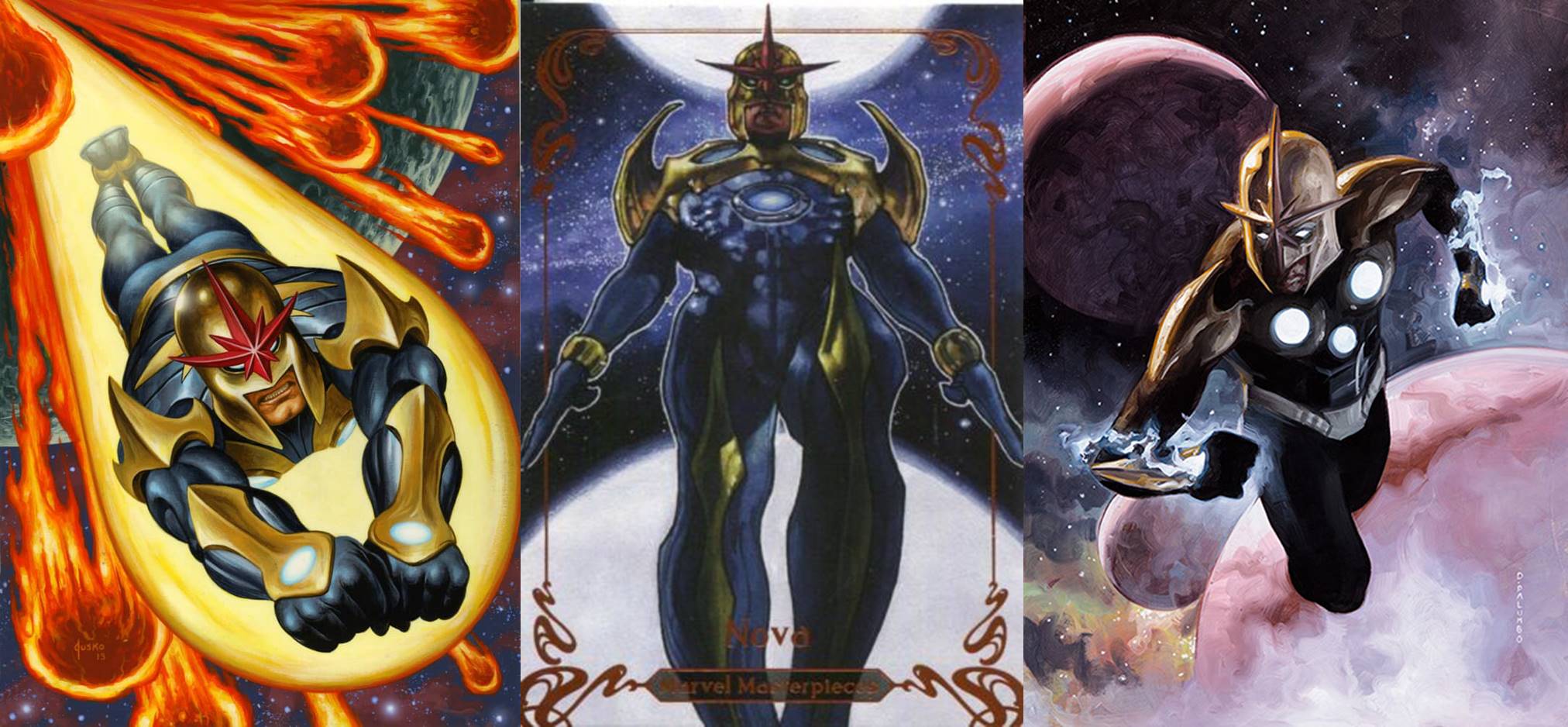
Left to Right: Nova by Joe Jusko, 2016; Nova by Simone Bianchi, 2018; Nova by Dave Palumbo, 2020.
This is another consistent use of costume across the three works, with each being almost identical save for a few minor details, like a single chest sphere in Bianchi’s work and Palumbo not using the spiked pauldrons seen in the other two. Each Nova is clearly flying in space, a planet of some sort at his rear, and with some display of energy and power, whether super obvious as in Jusko’s meteors or very subtle (look at the bracers) in the one by Palumbo.
One of the best parts about the Masterpieces sets is that a character like Nova, who might not be the most popular, can still stand the test of time to appear in each run. Will he be in MM22? We’ll just have to wait and see.
Wrapping Up
Well folks, we’re back to Earth, and here ends our look at the Heroes in Space that appear in the modern Marvel Masterpieces. These artworks act as nice examples of consistency, whether in costume like Nova, poise and pose like Captain Marvel, or just an overarching feeling, like Groot. Three artists working over an extended time period, and yet the result is still the timeless capture of some of the greatest pop culture icons in the history of the world. That’s pretty cool, and something you can only find in this set and series.
This is my last scheduled Parallels article that will look at all three artists’ works, but depending how long Marvel Masterpieces 2022 stays hidden, I may have some other avenues to compare and contrast the last remaining pieces we’ve yet to look at. And in the meantime, I’ll have my Marvel Unbound Quarterly Report finale, as well as the next edition of the Sketch Card Showcase and two other Marvel Masterpieces 2020 features I’ve been working on since this column began. You can keep up with all things Marvel Masterpieces 2020 by following me on Twitter. Feel free to ask questions or retweet to continue the conversation. Thanks and see you next time!
Donny Caltrider has been playing Magic since 2002 and collecting original Magic art since 2017. He has an M.A. in Museum Studies from Johns Hopkins University and enjoys telling stories about art, objects, and the intersection of fantasy with real-life. You can find him on Twitter talking about #mtgart, museums, and other #vorthos related goodness. Follow along and continue the conversation!

